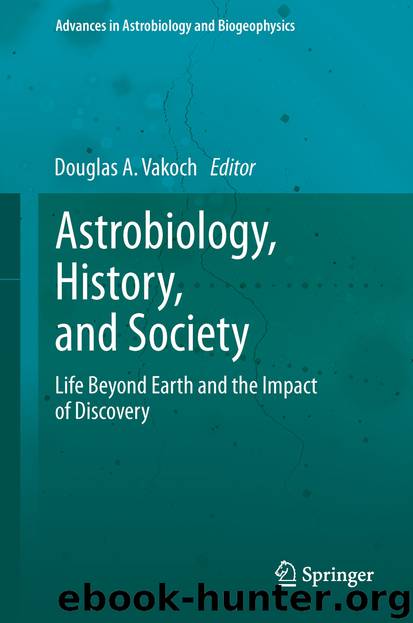Astrobiology, History, and Society by Douglas A. Vakoch

Author:Douglas A. Vakoch
Language: eng
Format: epub
Publisher: Springer Berlin Heidelberg, Berlin, Heidelberg
8.7 Present Studies
The work of Tikhov is particularly interesting for astrobiologists. At the present time, astronomers—without or before knowing Tikhov’s research—independently use again his methods in astrobotany as well as in observations of Earthshine. Of course we know now that there is no vegetation on Mars, but we can reasonably imagine that vegetation is present on other celestial objects.
In 1995, the discovery of the first extrasolar planet 51 Pegasi b by Michel Mayor and Didier Queloz was tremendous news for the world of astronomers, as well as for people in general. This discovery provided the answer to a philosophical question that humankind has wondered for more than 2,000 years. This first planet discovered was very rapidly followed by many others. A new very promising domain of astronomy is being developed very quickly, both in theoretical studies and in instrumentation. Many ground and space observational programs are planned and carried out.
In the near future, we can expect to see the image of a terrestrial planet located in the habitable zone. What kind of life could be detected on such a planet? How is it possible to detect life at the distance of an extrasolar planet that appears as merely a dot in the sky? So far, we don’t know anything about extraterrestrial life and the form it may take. The only possibility is to study and prepare for the detection of life similar to the only life we know, that is terrestrial life. So we search for evidence of life on the only planet known to harbor life, that is our Earth. To observe Earth under the same conditions as an exoplanet, we use Earthshine, where each point on the Moon reflects the light of the Earth facing the Moon. This idea was suggested by Jean Schneider, from Paris-Meudon Observatory, in 1998, without knowing any previous similar idea. Actually, as early as 1912, Arcichovsky suggested to look for chlorophyll absorption features in the Earthshine spectrum to calibrate this pigment in the spectrum of other planets, but the spectral resolution of spectrometers at that time was not sufficient for that purpose. This approach was completely forgotten until 1998.
No known animal life could be detected at the distance of an extrasolar planet, in contrast to vegetation that can cover vast areas. Very probably, the vegetation on extrasolar planets would be very different from that on Earth. For example, Kiang (2008) studies the colors and characteristics that plants would have on extrasolar planets, particularly according to the temperature of the central star of the planetary system. However, today Earth’s vegetation is the only target we can study and observe. A very distinctive signature of chlorophyll is the Vegetation Red Edge (VRE), around 0.7 μm, in the green vegetation reflectance spectra. A small bump is also present at 0.5 μm, which explains the green color of plants seen by our eyes. However, the VRE in the near infrared is much larger. If our eyes could see in the near infrared, plants would be seen as “infrared,” something like red and bright.
Download
This site does not store any files on its server. We only index and link to content provided by other sites. Please contact the content providers to delete copyright contents if any and email us, we'll remove relevant links or contents immediately.
| Aeronautics & Astronautics | Astronomy |
| Astrophysics & Space Science | Comets, Meteors & Asteroids |
| Cosmology | Mars |
| Solar System | Star-Gazing |
| Telescopes | UFOs |
Turbulence by E. J. Noyes(7098)
Tools of Titans by Timothy Ferriss(7009)
Astrophysics for People in a Hurry by Neil DeGrasse Tyson(4646)
Room 212 by Kate Stewart(4143)
Pale Blue Dot by Carl Sagan(4046)
The David Icke Guide to the Global Conspiracy (and how to end it) by David Icke(3922)
Secrets of Antigravity Propulsion: Tesla, UFOs, and Classified Aerospace Technology by Ph.D. Paul A. Laviolette(3677)
A Journey Through Divination and Astronomy by Publishing Pottermore(3290)
Apollo 8 by Jeffrey Kluger(3220)
Losing the Nobel Prize by Brian Keating(3193)
Goodbye Paradise(3012)
COSMOS by Carl Sagan(2976)
Brief Answers to the Big Questions by Stephen Hawking(2900)
How to Read Water: Clues and Patterns from Puddles to the Sea (Natural Navigation) by Tristan Gooley(2897)
The Five People You Meet in Heaven by Mitch Albom(2862)
The Order of Time by Carlo Rovelli(2766)
How to Read Nature by Tristan Gooley(2680)
A Brief History of Time by Stephen Hawking(2493)
Aliens by Jim Al-Khalili(2404)
